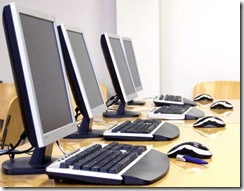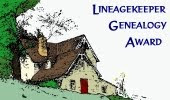Tonight 60 young folks from our area gathered together in a family history research party. They were looking for any of their ancestors who were pioneers in the western U.S. or who came to America in 'interesting' ways.
That doesn't sound much different than any of us does it?
We are all searching for our ancestors and know that most of them had very interesting stories in their lives if we can just find them.
Tonight, four of us 'old salts' scrambled from person to person answering questions and offering suggestions to aid in their search. The questions, the 'wahoos' associated with finds and the intuitive research thought processes of these young folks were impressive.
When they saw the LAN server setting on the floor hooked to tables of laptops and terminals, their first reaction was, "Hey, we are playing computer games tonight!". That wasn't correct, but it did provide a setting that most of them were used to and comfortable in.
I'd earlier created a website with a sixty or so family history research links on the home page for their quick reference, and with one glance at its listings and a few words of instruction, they were hot on the trail of their family.
Many pioneers were found, both those who traveled across the American west in wagons and handcart companies as well as those who were crammed into the compressed spaces aboard passenger ships dating from 1620 to recent days.
None of the keyboards melted. The DSL connection at our remote location staggered a few times, but was able to serve the load.
I couldn't honestly say that the four us us 'aides' were equally bushy tailed by the end of the research 'party' though. We scurried. We hurried. We tried to hear amidst the din of excitement, questions, chatting and clicking of keyboards during the entire event. Our responses ranged from "try any spelling of the name" to "how did you do that?" "Teach me!"
Yes, the shift was long enough for us 'aides' but way too short for the participants. They'd tasted the excitement of putting on their 'Sherlock hats' in the quest to find their ancestors. Almost all were infected with the research 'bug' and it will continue with them to some extent from this point in time on.
Once they made a 'find' and saw their ancestors name and learned a little about their lives, the 'hook' was set.
You can fight it. You can try to ignore it. But in the end, you'll give in and follow where it takes you and it will lead you back to finding your roots.
It feels good being a witness to this particular infection. Tired, but good.









4 comments:
youre a good man Lee
Lee,
This sounds really fascinating. Can you tell me more about it?
1) What was the target age group? How were they selected?
2) How did you set this up genealogically? Did each bring a pedigree chart or FGS? Or did you give them someone to find records for?
3) How did you set this up technologically? Where was it set up, what genie resources did you make available, etc?
4) Was this part of a church, school, or library program?
I'd love to try something like this for Family History Month in October. My Board will kill me for suggesting something else that's new, though!
Please email me at rjseaver@cox.net if you want.
Thanks -- Randy
Randy,
I'll shoot you a note directly, but others may be interested in the answers too.
1. The ages of the youth were 12 through 18.
2. The young folks brought pedigree charts with with if any existing research had been done about their family. Absent a chart, we asked them to bring the names and dates of their deceased grandparents or great grandparents and started from there. (cell phone calls to mom and dad or grandma and grandpa filled in any forgotten information).
3. We had a WiFi connection and set up a bridge for the hardwired workstations and tied them in via a hub. The laptops all supported WiFi, so it was just a matter of entering the WPA key in each of the laptops.
4. It was a church group. They are going to participate in a week long 'trek' this summer to partially experience the trials their pioneer ancestors 'enjoyed'.
The goal was to see if the young folks could find any of their ancestors who migrated westward over any of the overland trails.
Of course, not everyone had 'pioneer' ancestors, but almost all have European ancestors, so they naturally had 'pioneer' ancestors who traveled to North America in less than favorable conditions.
Linking someone 'real' in their ancestry to each of the young folks, will make the trek much more memorable for them.
Hopefully, they'll follow through and search through the files at home for photos, histories and other memorabilia of their pioneer and immigrant ancestors to further enhance their linkage to their ancestors.
An unasked question was how many support folks did we have at the 'Party'. There were four of us and we rotated the three groups about every 45 minutes.
The youth went to other rooms and learned how to search for photos, trace migration routes and write their own histories as part of the 'Party'.
If you have an equally large group, try to get 5 or so support folks who know how to do research on the Web and how to keep the browsers pointed to the right URL's, etc.
The four of us were extremely busy keeping up with the quick minds and web awareness of these young folks.
Also, have a stack of blank pedigree charts and group sheets on hand and several boxes of pencils and pens. You'll quickly use them up.
Try it in your group. You'll have a lot of fun with the folks who participate. The excitement builds as discoveries are made and the cheers ring out.
Great idea, Lee.
When our daughter was a leader of her Jewish youth group in 1990s southern Nevada, the group (8-12th graders, about 300 kids and staff) had a six-state weekend conference at our home synagogue. I had suggested a gen activity (among all the rest of the busy weekend). We sent questionnaires to all attendees, and received a 98% return. We mapped ancestral towns and how they got to where they were today and where they were along the way (sometimes several countries). Along with the huge maps, we had printouts of family names and ancestral towns. Several kids' ancestors came from the same place, which was very interesting to them. It was a popular exhibit for the kids, staff and parents. And I even found a new Talalay cousin. A student from southern California had sent his form back, and as I was transcribing it into a computer file, I noticed the grandmother's name (Talalay!). I shrieked and grabbed the phone. We had known this family for several years but never knew we were related! Even better, the grandmother had had a professional genealogist construct a family tree back in the 1940s and the mother found it in a box of things inherited from her mother. The "things" included a large packet of Yiddish letters and photographs from the family back home.
Programs like these are always good!
Schelly
Tracing the Tribe - The Jewish Genealogy Blog
http://tracingthetribe.blogspot.com
Post a Comment